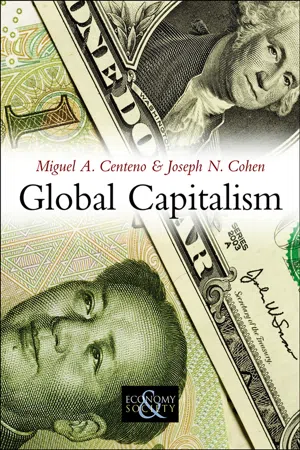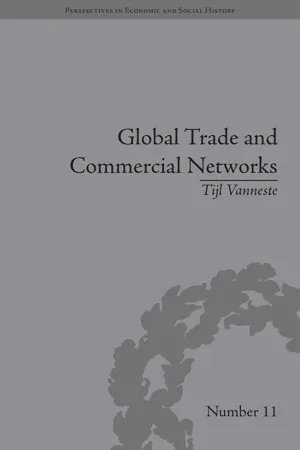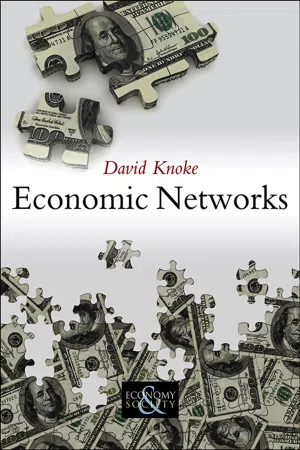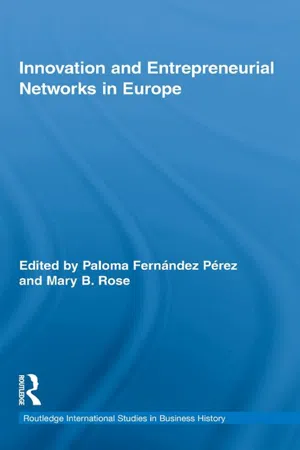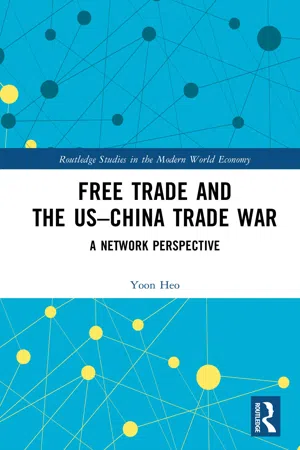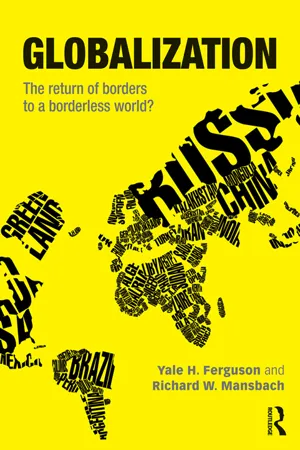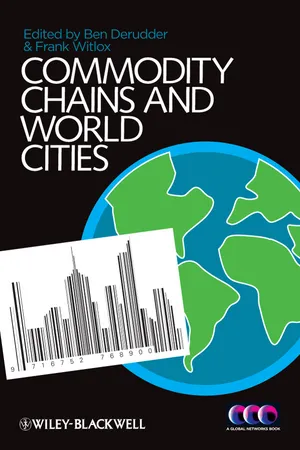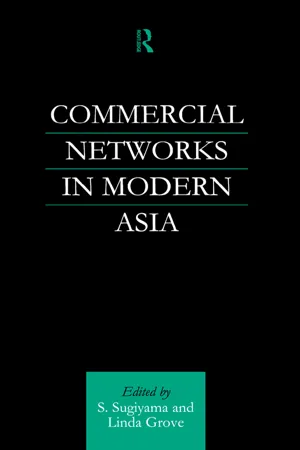History
Global Trade Networks
Global trade networks refer to the interconnected system of trade routes and economic exchanges that have linked different regions of the world throughout history. These networks facilitated the exchange of goods, ideas, and cultures between distant societies, contributing to the development of global economies and shaping the course of human history.
Written by Perlego with AI-assistance
Related key terms
Related key terms
1 of 4
Related key terms
1 of 3
10 Key excerpts on "Global Trade Networks"
- eBook - ePub
Global Capitalism
A Sociological Perspective
- Miguel A. Centeno, Joseph N. Cohen(Authors)
- 2013(Publication Date)
- Polity(Publisher)
and landlocked is very onerous.) Much as the best restaurant will languish if it is in the wrong location, even the most productive country may not be able to participate in a global market in a useful way if the global highway has passed it by.Over the past two decades, several scholars have sought to better understand global trade flows by borrowing perspectives and methodologies from network theory (Gereffiand Korzeniewicz 1994; Kick and Davis 2001; Kim and Shin 2002; Mahutga 2006; Piana 2006). While some have argued that the global trade network has become flatter and more decentralized, most of the evidence points to the asymmetries first observed in the nineteenth century. With the prominent exception of those countries that succeeded in making a development leap through trade beginning in the 1970s, the global trade structure looks remarkably similar to that in the 1960s, even if its contents and micro-level geography are more complex. Those countries at the top of the heap at the beginning of the latest stage of globalization remained the ones that participated in the most profitable stages of manufacture, while those on the bottom did the literally dirtier and cheaper work. Moreover, the countries closer to the top of the network had a more diversified trade portfolio in terms of both products and partners, thus allowing them to deal better with temporary fluctuations.4In network terms, the world might be described as consisting of three dominant blocs or cliques: North America, Europe, and Asian Pacific Rim. Each member of these groups deals mostly with others in the same clique (roughly 8 percent, 32 percent, and 14 percent of global trade respectively), but there is significant contact between the three groups as well (24 percent). An especially important relationship here is between the US and China. Not only are these flows significant in their own right, but the American trade deficit is paralleled by massive Chinese lending to the US (see chapter 3 - eBook - ePub
Global Trade and Commercial Networks
Eighteenth-Century Diamond Merchants
- Tijl Vanneste(Author)
- 2015(Publication Date)
- Routledge(Publisher)
103 In a similar sense as the above-mentioned spatial histories, world history can be defined as the study of an international space, the world, by seeing it as an interconnected area. In this manner, world history becomes the history of the development of such interconnectedness, or, in other words, the history of globalization. Its task becomes the analysis of worldwide integration within the global historical space by analysing human interaction that took place within this space. A soft definition of globalization fits perfectly within this framework, in its emphasis on human change brought about by permanent global international relationships. These relationships can be commercial, while human change can be social, cultural, commercial or political. This definition of world history is perfectly compatible with historical network analysis.Combining Two Notions of Networks
If trade is to be seen as a worldwide integrative force, it should first be analysed from within. Fundamental to the idea of international commerce as one of the main carriers of globalization and economic growth is the observation that at some point in the exchange line, it became cross-cultural, meaning merchants who belonged to a different culture, religion, nation or background were doing business together. In a very interesting article, Jerry Bentley has put forward the idea that different degrees of cross-cultural interaction allow for a periodization of world history based on the level of worldwide integration.104 A changing perception of the world we live in today has caused historical explanation from a transnational point of view to a cross-cultural one. Jonathan Israel attributed to Sephardic trading networks an important role in European maritime expansion from 1492 to the end of the eighteenth century, and in doing so he claimed that this vital role was not caused by ‘“idiosyncratic” Jewishness but by very specific, novel and complex sets of international circumstances forging a new, world-political context interacting on characteristic Jewish forms of community and social organization’.105 - eBook - ePub
- David Knoke(Author)
- 2014(Publication Date)
- Polity(Publisher)
Economic globalization involves increasing integration of local, regional, and national economies into international economic networks, through such dynamic relations as exports and imports, foreign direct investment, financial capital flows, labor migration, technology transfers, and diffusion of knowledge and innovations. Some analysts stressed noneconomic relations – political, military, cultural, scientific – as additional ties sustaining and strengthening global economic interdependence. Recent studies of transnational diffusion of public policies and institutions emphasized how economic networks facilitate the spread of information and ideas, and the adoption of policies and practices, from nation to nation. For example, Mauro Guillén and colleagues identified effects of network cohesion and structural equivalence on the worldwide diffusion of ISO 9000 quality certification standards (Guler et al. 2002); on the spread of central bank independence (Pollilo and Guillén 2005); and four market-oriented infrastructure reforms (Henisz et al. 2005).Nations with close proximity in networks of transnational portfolio investments and exports were more likely to adopt similar top corporate tax rates, primarily through policy learning and emulation processes (Cao 2010). “We find evidence of the network socialization mechanism in the networks of IGOs [intergovernmental organizations] and the evidence is much stronger in the IGO networks that facilitate policy learning than in the IGO networks that facilitate policy emulation” (p. 850). These and other studies underscore the importance of economic ties among nations in the modern era of globalization.Globalization is not a contemporary phenomenon. The extensive Silk Road network of trade routes connecting Chinese and Indian markets to the Mediterranean flourished from the first century BCE . Western European voyages of discovery and subsequent colonization of overseas territories began in the fifteenth century. Much globalization theorizing and empirical research concentrates on the past 500 years and the twentieth century in particular. Modernization and development theorists in the 1950s argued that traditional societies would follow a single evolutionary path from poverty to prosperity by integrating into the world economic and sociopolitical systems. Advanced industrial democracies could assist “underdeveloped” countries to modernize their economies and societies through such policies as free trade, direct capital investment, government foreign aid, and people-to-people assistance programs like the Peace Corps. The belief that globalization generally promotes economic development and prosperity everywhere still echoes in popular treatments such as Thomas Friedman’s The World Is Flat - Paloma Fernández Pérez, Mary Rose(Authors)
- 2009(Publication Date)
- Routledge(Publisher)
2 Networks in Economic and Business History A Theoretical PerspectiveMark CassonINTRODUCTION
Networks as an Inter-disciplinary Subject
Networks are everywhere. In physics there are electrical circuits; in civil engineering there are structures such as bridge trusses; in information technology there are telephones and the Internet; while in geography there are transport systems, such as motorways and railway systems. Agriculture and industry depend upon distribution systems (pipelines, electricity grids) and disposal systems (drainage ditches, sewage systems). In biology the brain is analyzed as a network of neurons, and in anthropology family networks are created and sustained through reproduction. Economists refer to networks of trade, investment and technology transfer when discussing international and inter-regional resource flows. Sociologists analyze social groups in terms of interpersonal networks and use network effects to explain ‘chain migration’ flows, while business strategists analyze networks of strategic alliances between firms.Networks are a powerful way of understanding the historical evolution of economic and social institutions. Institutions are often analyzed in terms of firms, markets and the state (North 1981). Networks are then introduced as a fourth type of institution. However, this approach is not sufficiently radical. Networks are an emerging paradigm for economic and social history. But to exploit the potential of this paradigm fully, there needs to be more agreement and greater clarity over the definition of terms. There are many different types of networks, involving different types of elements connected up in different ways using different kinds of relationships. Confusion is created when researchers fail to define their terms and to specify which type of network they are writing about.Ambiguities of the Subject
When analyzing networks, different disciplines refer to the same concepts by different names. The members of a network are variously referred to as elements, nodes, vertices and points, while the connections between them are referred to as linkages, edges, paths and so on.- eBook - ePub
Free Trade and the US–China Trade War
A Network Perspective
- Yoon Heo(Author)
- 2022(Publication Date)
- Routledge(Publisher)
2 The Global Trading System from a Network Perspective DOI: 10.4324/9781003305705-2 Global trade has faced many setbacks in recent years. Mounting trade tensions, growth in trade restrictions, and continued economic uncertainty caused by the four waves of challenges have posed substantial threats to world trade. In this regard, virtualizing the situation in the image of a network provides us a clearer view of the interaction among countries and the impact created by one country on the whole system. Network theory also helps to answer the questions of whether non-state factors can call the signals in the world, what the determinants of power in the world trade system are, how the structure of the system is shaped, and how member countries connect with each other. Since traditional economic and political theories no longer seem capable of clearly presenting the issues involved, we examine the major tenets of network theory and apply them to the analysis of the global trading system. This analysis incorporates the collision of inner and outer networks, network power, network structure, and communication patterns within the system. 2.1 Why Network Theory? A network can be defined as a complex system with two core elements: node s (vertices) and links (edges). This concept appears in academic discussions and commentaries on an enormous range of topics. It often appears in assessments of information networks, where the nodes represent information resources, such as Web pages or documents, and the edges represent logical connections, including hyperlinks, citations, and cross-references. In social networks, the nodes are people or groups of people, and the edges represent diverse types of social interaction, possibly mutual exchanges of goods and ideas - eBook - ePub
Globalization
The Return of Borders to a Borderless World?
- Yale H. Ferguson, Richard W. Mansbach(Authors)
- 2012(Publication Date)
- Routledge(Publisher)
Much the same might be said of the definition offered by the Princeton/Washington project on “Mapping Globalization,” as follows: We have adopted a comprehensive definition of globalization that is simply based on geographically expanding networks of transactions, where transactions may be of any type, and may have occurred at any time. This naturally supports a strongly historical perspective that includes trade, migration, transportation, communication, empires, and so on. 8 In our view, globalization is an evolutionary non-unilinear process that has multiple interrelated dimensions: ecology, disease, demography, economics, technology, culture, politics, military, and society. These categories are by no means the only possible ones, nor are they mutually exclusive. They overlap and can easily be subdivided. For example, “culture” may be interpreted to encompass most of human affairs. “Military” and “economics” are often highly “political,” as indeed is immigration in the realms of “demography” and “society.” “Technology” applies equally well to military as to communications and transportation or to the production of goods. “Economics” may be subdivided into production, trade, and finance. And on and on. The following, then, are essential parts of our larger conception of globalization: It is a non-unilinear evolutionary process: that is, it ebbs and flows and typically does so unevenly in its different dimensions. Therefore, speaking of globalization as a single phenomenon is highly misleading. It is multidimensional, however those dimensions may be grouped, divided, and subdivided. Different dimensions routinely overlap to some degree and also influence one another - Manuel Sánchez, Klemens Kaps, Manuel Herrero Sánchez, Klemens Kaps(Authors)
- 2016(Publication Date)
- Routledge(Publisher)
45 the transformation of consumption patterns, and the densification of trade routes. The definition is, indeed, very broad, and it incorporates not only economic but also social and cultural factors. It is very clear that such a process had already taken place when the Old and the New Worlds came together, but also that it does not amount to economic globalisation; more accurately, the phenomenon should be addressed as internationalisation.Putting it simply, globalisation is the phenomenon that leads to the construction of an international market by lowering barriers and improving transport. The economic definition of globalisation involves three different aspects: commodities, barriers and transport systems. Regarding the first aspect, most historians know that Atlantic trade was based on luxury goods and not on commodities.46 Of course, this is only true for imports. European exports are a very different issue: the top five include olive oil, wine and even cereals, three basic components of the Mediterranean diet.Concerning barriers, historical evidence is very clear. In the Atlantic, trade barriers did not decline but actually increased. Specific new taxes, for example, were created for commercial transactions with the Spanish colonies. This is the case with the Almojarifazgo de Indias or the Averia , two very different taxes which were, nevertheless, tailor-made for trade with the New World.47 It is commonly accepted that the Spanish monopoly in America was not really a monopoly from an economic point of view, but rather an apparatus designed to raise revenue via taxation.Finally, the issue of the development of the transport system and the reduction of freight costs is more controversial. The period that followed the discovery of America was one of vast improvement in shipbuilding and navigation technologies, resulting in a very significant reduction in shipping costs. The statement by K. O’Rourke and J. Williamson about the slight reduction of freight costs in Atlantic trade in the sixteenth century is supported by little evidence. They use Hamilton’s classic data for the trade in dried codfish between Andalusia and Valencia to argue that progress in navigation during the sixteenth and the seventeenth centuries had no effect on freight costs. It seems nonsense to extrapolate trading conditions among Spanish ports to the Atlantic trade.- eBook - ePub
- Ben Derudder, Frank Witlox, Ben Derudder, Frank Witlox(Authors)
- 2011(Publication Date)
- Wiley-Blackwell(Publisher)
8 Making connections: Global Production Networks and World City Networks NEIL M. COE, PETER DICKEN, MARTIN HESS AND HENRY WAI-CHEUNG YEUNGAmong the myriad networks that make up the complex fabric of the global economy two, in particular, stand out. One is constituted by the circuitous processes of production, distribution and consumption. How these are articulated and coordinated derives from complex, asymmetrical interactions between a number of actors and institutions. Such actors and institutions are, themselves, deeply embedded in broad social structures and firmly grounded in specific places and geographies. These geographies constitute the second major network. The global economy, therefore, can be conceptualized as the complex inter-digitation of organizational networks, in the form of production circuits and networks, and geographical networks, in the form of localized clusters and webs of economic activities (Dicken 2007; Dicken et al. 2001). In fact, of course, the two networks are totally interconnected. They constitute two sides of the same coin. We cannot understand how the global economy works without appreciating its complete embeddedness in, and shaping by, specific geographies. Equally, we cannot understand such geographies without appreciating how they are shaped by the complex interconnections within and between production networks organized at different spatial scales (often regional and global). So far, however, there is relatively little work on the connections between these two kinds of network. Within geography, for example, political/economic geographers concern themselves with production networks while political/urban geographers concern themselves with cities and networks of cities. The twain rarely, if ever, meets.In that respect, the theme of this book is especially apposite. It is concerned with the conceptual relationship between two particular variants of these two kinds of network: World City Networks (WCNs) and Global Commodity Chains (GCCs). In the individual chapters, the authors address, to a greater or lesser degree, and to a more theoretical or empirical extent, how these two approaches can be productively integrated and recombined into ‘a key analytical lens through which the geographies of contemporary globalization are being studied’ (Brown et al. this book). As economic geographers with vested interests in heated debates in both strands of the literature in geography, urban studies, development studies and international political economy, we welcome this analytical effort towards integration and synthesis. We believe that such cross-fertilization of different analytical frameworks in the study of global networks is not only crucial in engendering the future viability of their subject matter for research, but also reflective of the growing maturity and acceptance of these frameworks in the wider social sciences. - eBook - ePub
Global Trade
Past Mistakes, Future Choices
- Greg Buckman(Author)
- 2013(Publication Date)
- Zed Books(Publisher)
1 A history of global tradeIt is easy to take a given phenomenon and project backwards convincing oneself along the way that it has always been much as it is at present. It is particularly easy to do this with global trade, to kid oneself that today’s highly integrated web of global trade must always have been much as it is at present. It is also easy to think that because high-income countries dominate today’s world trade they must always have dominated global trade. But both impressions are a long way from the truth. Because these impressions are incorrect it is important to have an understanding of the evolution of global trade so one can have a proper context for the politics of it.Although integrated global trade is a relatively new phenomenon, various forms of trade between different parts of the world have been in existence for a long time; in fact some types of global trade have existed for a very long time. Ivory from Africa has been discovered in Celtic graves in Britain. Volcanic glass mined in prehistoric times in present-day Turkey has been found throughout lands thousands of kilometres from the country.1 - eBook - ePub
- Linda Grove, Shinya Sugiyama(Authors)
- 2013(Publication Date)
- Routledge(Publisher)
However, there is no question that there were also commercial networks in Western Asia that paid no heed to national borders, and which allowed for the free movement of goods, people, money and information over vast spatial areas. Let me mention two examples of this kind of commercial network. One was the sea-based network and marketing zone stretching from the eastern Mediterranean Sea to the Aegean and Black Seas. The second was the trading zone in the steppe regions of Iran and Anatolia. Finally, building on these two types of trading networks was the third level of commercial network in Western Asia, those that involved European capitalism.The market economy system based on European capitalism, building on the indigenous, multi-layered commercial networks and market zones in Western Asia, created a world trading system in the region. How this world system intersected with the Western Asian trading networks is the story we will explore in the rest of this paper. Before doing so I would like to raise some questions about the existing analytical framework which has stressed the European domination over the trading system that evolved. While there is no question that Western Asia was eventually incorporated into a world system led by European capitalism, the new world system did not eliminate all traces of the earlier indigenous trading systems. Within the new world trading system there were some commodities that were still traded in relatively traditional or autonomous trade networks, and many of the Western Asian traders continued to survive. In this essay I want to put the spotlight on those parts of the Western Asian networks that were able to resist the power of the expanding capitalist trading system.In this paper I will use the general framework outlined above to examine the trade in silk and cocoons which was so important for Iran. The silk and cocoons produced in Iran were transported across Anatolia to Istanbul, and from there they were shipped to their final destinations, Lyon and Milan. As we follow the trade in silk and cocoons, we will also be following in the footsteps of the various merchants involved in the Western Asian trade.
Index pages curate the most relevant extracts from our library of academic textbooks. They’ve been created using an in-house natural language model (NLM), each adding context and meaning to key research topics.
Explore more topic indexes
Explore more topic indexes
1 of 6
Explore more topic indexes
1 of 4
